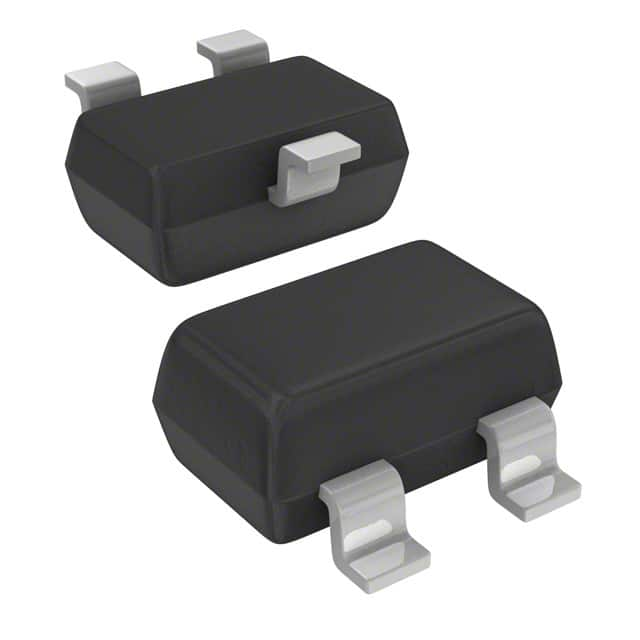HSMS-286B-TR1
Introduction
HSMS-286B-TR1 is a high-frequency surface mount Schottky barrier diode designed for use in various electronic applications. This entry provides an overview of the product, including its category, use, characteristics, packaging, specifications, pin configuration, functional features, advantages and disadvantages, working principles, application field plans, and alternative models.
Basic Information Overview
- Category: Electronic Components
- Use: HSMS-286B-TR1 is commonly used in high-frequency applications such as mixers, detectors, and multipliers.
- Characteristics: This diode offers low series resistance, low forward voltage, and fast switching capabilities, making it suitable for high-frequency circuits.
- Package: The HSMS-286B-TR1 is available in a surface mount package.
- Essence: It serves as a crucial component in RF and microwave circuit designs.
- Packaging/Quantity: Typically supplied in reels or tubes containing a specified quantity per package.
Specifications
- Forward Voltage: 0.3V (typical)
- Reverse Voltage: 15V
- Maximum DC Current: 1A
- Operating Frequency: Up to 10GHz
- Package Type: Surface Mount
- Operating Temperature Range: -55°C to +150°C
Detailed Pin Configuration
The HSMS-286B-TR1 features a standard surface mount package with two pins. Pin 1 is typically designated as the anode, while pin 2 serves as the cathode.
Functional Features
- High-Frequency Operation: Capable of operating at frequencies up to 10GHz.
- Low Forward Voltage: Provides efficient energy conversion in high-frequency circuits.
- Fast Switching: Enables rapid signal processing in RF and microwave applications.
Advantages and Disadvantages
Advantages
- High-frequency capability
- Low forward voltage
- Fast switching speed
Disadvantages
- Limited reverse voltage tolerance
- Sensitive to overvoltage conditions
Working Principles
The HSMS-286B-TR1 operates based on the Schottky barrier principle, where the metal-semiconductor junction allows for fast switching and low forward voltage drop. When forward-biased, the diode conducts current efficiently, making it suitable for high-frequency signal processing.
Detailed Application Field Plans
The HSMS-286B-TR1 finds extensive use in the following application fields: - RF Mixers - RF Detectors - RF Multipliers - Microwave Signal Processing
Detailed and Complete Alternative Models
Several alternative models to the HSMS-286B-TR1 include: - HSMS-286C-TR1 - HSMS-286A-TR1 - HSMS-286D-TR1 - HSMS-286E-TR1
These alternatives offer similar high-frequency performance and are compatible with various RF and microwave circuit designs.
In conclusion, the HSMS-286B-TR1 is a critical component in high-frequency electronic applications, offering fast switching, low forward voltage, and efficient operation at frequencies up to 10GHz. While it has limitations in reverse voltage tolerance, its advantages make it a preferred choice in RF and microwave circuit designs.
Word count: 443
Lista 10 Vanliga frågor och svar relaterade till tillämpningen av HSMS-286B-TR1 i tekniska lösningar
What is HSMS-286B-TR1?
- HSMS-286B-TR1 is a technical reference document that provides guidelines and best practices for implementing secure communication protocols in high-speed data transmission systems.
Why is HSMS-286B-TR1 important?
- HSMS-286B-TR1 is important because it helps ensure the security and integrity of data transmitted over high-speed networks, which is crucial for protecting sensitive information and maintaining system reliability.
How does HSMS-286B-TR1 impact technical solutions?
- HSMS-286B-TR1 impacts technical solutions by providing specific recommendations for implementing secure communication protocols, which can help developers and engineers design systems that meet industry standards for data security.
What are the key requirements outlined in HSMS-286B-TR1?
- The key requirements outlined in HSMS-286B-TR1 include encryption standards, authentication mechanisms, data integrity checks, and guidelines for secure key management.
How can HSMS-286B-TR1 be applied to network infrastructure?
- HSMS-286B-TR1 can be applied to network infrastructure by guiding the implementation of secure communication protocols, such as TLS or IPsec, to protect data transmitted across networks.
What are the common challenges in implementing HSMS-286B-TR1 in technical solutions?
- Common challenges in implementing HSMS-286B-TR1 may include compatibility issues with existing systems, performance overhead from encryption processes, and ensuring compliance with the document's recommendations.
Are there any industry-specific considerations when applying HSMS-286B-TR1?
- Yes, industry-specific considerations may include regulatory requirements, unique threat landscapes, and the need to integrate with specialized hardware or software components.
What are the benefits of adhering to HSMS-286B-TR1 in technical solutions?
- Adhering to HSMS-286B-TR1 can lead to improved data security, reduced risk of unauthorized access or tampering, and alignment with industry best practices for secure communication protocols.
How can organizations ensure compliance with HSMS-286B-TR1?
- Organizations can ensure compliance with HSMS-286B-TR1 by conducting regular security assessments, implementing recommended controls, and staying informed about updates or revisions to the document.
Where can I find additional resources for understanding and applying HSMS-286B-TR1?
- Additional resources for understanding and applying HSMS-286B-TR1 may include industry forums, technical publications, and consulting with experts in secure communication protocols and network security.


